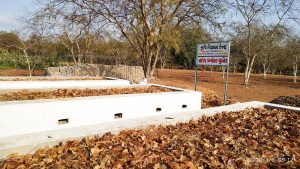NADEP compost unit
NADEP compost unit
Krishi vigyan Kendra Mehsana has well established NADEP compost unit. The NADEP method of organic composting uses a wide range of organic materials such as crop residues, weeds, forest litter and kitchen waste with an end-product of a fertilizer that serves as a good alternative to farmyard manure.


Why Nadep Unit?
- The Nadep method of making compost is unique not because it is successful in making good compost, which other methods can also lay claim to; its real secret lies in the large quantities of compost the process can deliver with a minimum of human effort within a specific period of time.
- The process basically involves placing select layers of different types of compostable materials in a simple, mud-sealed structure designed with brick and mud water.
- The system permits conversion of approximately 1 kg of animal dung into 40 kg of rich compost which can then be applied directly to the field.
- The multiplication factor is significant in view of the fact that in the tropics, there is rapid decomposition of organic materials in the soil.
- This organic matter must be replaced and replenished if agricultural fertility is not to go on declining.
- The problem is there is a scarcity of compostable materials, particularly animal dung, prevailing within the country. (A good proportion of animal dung is dried and used as fuel in many rural areas.) Thus, even if all available organic materials, including dung, were religiously and scrupulously collected, they would still not be sufficient to replace the organic constituents of the vast quantities of India’s fast-degrading soils.
- The Nadep method of composting actually enables the farmer to get around the difficulty of generation of mass and to increase the quantity of compost rapidly within a given frame of time and without any significant additional expense.
- Compost can be prepared from a wide range of organic materials including dead plant material such as crop residues, weeds, and forest litter and kitchen waste.
- Compost making is an efficient way of converting all kinds biomass into high value fertilizer that serves as a good alternative to farmyard manure, especially for crop-growing households without livestock.
Discription
- This method of making compost involves the construction of a simple, rectangular brick tank with enough spaces maintained between the bricks for necessary aeration.
- The recommended size of the tank is 10 ft (length) x 5 ft (breadth) x 3 ft (height).
- All the four walls of NADEP tank are provided with 6// vents by removing every alternate brick after the height of 1ft. from bottom for aeration.
- Tank can be constructed in mud mortar or cement mortar.
Establishment Activities
Raw materials required for filling NADEP tank
- Agricultural waste (Dry & green) – 1350-1400 kgs.
- Cattle dung or biogas slurry – 98 – 100 kgs.
- Fine sieved soil – 1675 kgs.
- Water – 1350-1400 litres.
- The important technique in the manufacture of Nadep compost is that the entire tank should be filled in one go, within 24 hours and should not go beyond 48 hours, as this would affect the quality of the compost.
- Thatched roof, Brick Wall Flooring, Air Vents, Green-farm technologies for small and marginal farms Resources Center for Sustainable Development
- Before filling: the tank is plastered by dilute cattle dung slurry to facilitate bacterial activity from all four sides. It is also filled in definite layers each layer consisting of the following sub layers.
Sub-layer-1
- 4 to 6// thick layer of fine sticks, stems, (To facilitate aeration) followed by 4 to 6// layer ofdry and green biomass.
Sub-layer-2
- 4 kgs. Cow dung is mixed with 100 litres of water and sprinkled thoroughly on the agricultural waste to facilitate microbial activity.'
Sub-layer-3
- 60 kgs. of fine dry soil is spread uniformly over the soaked biomass for moisture retention and acts as a buffer during biodegradation. Thus the proportion of organic materials for each layer is 100 kgs. Organic biomass: 4kgs.cowdung + 100 litres water+60 kgs soil. In this way, approximately 10 -12 layers are filled in each tank. After filling the tank, biomass is covered with 3// thick layer of soil and sealed with cow dung +mud plaster.
Maintenance and Benefits
Maintenance
- After 15-30 days of filling the organic biomass in the tank gets automatically pressed down to 2 ft.
- The tank is refilled by giving 2-3 layers over it and is resealed.
- After this filling the tank is not disturbed for 3 months except that it is moistened at intervals of every 6-15 days.
- The entire tank is covered with a thatched roof to prevent excessive evaporation of moisture.
- Under no circumstances should any cracks be allowed to develop. If they do, they should be promptly filled up with slurry.
Benefits
- Reduced cash expenses on chemical fertilizer, improved soil fertility, increased crop yield.
- Supports organic crop production, reduced dependence on outside inputs.
- From each NADEP tank approximately 2.5 tons of compost is prepared within 90-120 days.
- The use of compost reduced the need for mineral fertilizer thus reducing production costs and outside dependence.